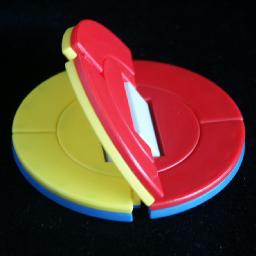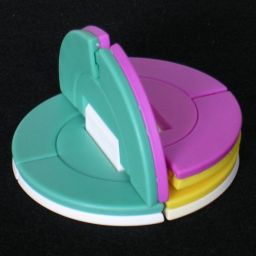



This is a simple but odd little puzzle. It consists of three semicircles which are hinged together. Each pair of semicircles can be held flat forming a round face, so there are three such faces with a single colour each. Around the edge of each face is a ring four pieces which can rotate around the face. The pieces have two colours, because they have two sides which belong to different faces. There are 6 pieces altogether, in three pairs of identical pieces. Versions with 4 semicircles are slightly more common, and these often have printed designs on them or have unusual colour schemes.
This puzzle was patented by Fritz Gruber on 7 December 1993, US 5,267,731.
If your browser supports JavaScript, then you can play the (three faced) Roundy puzzle by clicking the link below:
On the basic version with three faces there are 6 pieces with 2 orientations each, giving a maximum of 6!·26 positions. This limit is not reached because:
This leaves 6!·22 = 2,880 positions.
This number of positions of this version of the puzzle is one of the lowest of all the puzzles in my collection, and yet it is certainly not trivial. None of the positions need more than 9 quarter turns to solve, or 7 face turns (on average, 5.4465 quarter turns or 4.5688 face turns). There is only one position that needs 9 quarter turns, and this is the position with all the pieces flipped.
| Face turn metric | ||||||||||
|---|---|---|---|---|---|---|---|---|---|---|
| 0 | 1 | 2 | 3 | 4 | 5 | 6 | 7 | Total | ||
| Q r t r t u r n m t r | 0 | 1 | 1 | |||||||
| 1 | 6 | 6 | ||||||||
| 2 | 3 | 24 | 27 | |||||||
| 3 | 24 | 90 | 114 | |||||||
| 4 | 6 | 126 | 218 | 350 | ||||||
| 5 | 39 | 474 | 366 | 879 | ||||||
| 6 | 6 | 198 | 691 | 174 | 1,069 | |||||
| 7 | 27 | 183 | 176 | 12 | 398 | |||||
| 8 | 2 | 6 | 27 | 35 | ||||||
| 9 | 1 | 1 | ||||||||
| Total | 1 | 9 | 54 | 261 | 919 | 1,246 | 378 | 12 | 2,880 | |
In Sloane's On-Line Encyclopedia of Integer Sequences these are included as sequences A079742 and A079817.
If all 6 pieces are distinct, then the puzzle needs up to 12 quarter turns or 10 face turns to solve (on average 7.0585 and 6.0739 moves). There is only one position that needs 12 quarter turns, and as you would expect it is the position with all the pieces flipped.
| Face turn metric | |||||||||||||
|---|---|---|---|---|---|---|---|---|---|---|---|---|---|
| 0 | 1 | 2 | 3 | 4 | 5 | 6 | 7 | 8 | 9 | 10 | Total | ||
| Q r t r t u r n m t r | 0 | 1 | 1 | ||||||||||
| 1 | 6 | 6 | |||||||||||
| 2 | 3 | 24 | 27 | ||||||||||
| 3 | 24 | 90 | 114 | ||||||||||
| 4 | 6 | 144 | 312 | 462 | |||||||||
| 5 | 54 | 630 | 996 | 1680 | |||||||||
| 6 | 9 | 366 | 2298 | 1971 | 4644 | ||||||||
| 7 | 60 | 1314 | 4216 | 1905 | 7495 | ||||||||
| 8 | 5 | 84 | 1890 | 3762 | 393 | 6134 | |||||||
| 9 | 66 | 1130 | 969 | 45 | 2210 | ||||||||
| 10 | 18 | 138 | 90 | 5 | 251 | ||||||||
| 11 | 6 | 9 | 15 | ||||||||||
| 12 | 1 | 1 | |||||||||||
| Total | 1 | 9 | 54 | 297 | 1373 | 4692 | 8143 | 6815 | 1500 | 141 | 15 | 23040 | |
In Sloane's On-Line Encyclopedia of Integer Sequences these are included as sequences A079742 and A079817.
This version can always be solved in 9 quarter turns or 9 face turns (6.6699 and 6.0525 moves on average respectively).
| Face turn metric | ||||||||||||
|---|---|---|---|---|---|---|---|---|---|---|---|---|
| 0 | 1 | 2 | 3 | 4 | 5 | 6 | 7 | 8 | 9 | Total | ||
| Q r t r t u r n m t r | 0 | 1 | 1 | |||||||||
| 1 | 8 | 8 | ||||||||||
| 2 | 4 | 40 | 44 | |||||||||
| 3 | 40 | 184 | 224 | |||||||||
| 4 | 10 | 288 | 772 | 1070 | ||||||||
| 5 | 84 | 1320 | 2680 | 4084 | ||||||||
| 6 | 8 | 312 | 4332 | 6334 | 10986 | |||||||
| 7 | 12 | 688 | 7632 | 6428 | 14760 | |||||||
| 8 | 1 | 564 | 6616 | 878 | 8059 | |||||||
| 9 | 216 | 852 | 16 | 1084 | ||||||||
| Total | 1 | 12 | 90 | 564 | 2417 | 7700 | 14530 | 13260 | 1730 | 16 | 40320 | |
On the three face version, denote the faces by L, F, and R, meaning
left, front and right respectively. Moves are denoted by the letter of the face
involved. Quarter turns clockwise just use the letter, half turns are
denoted by the letter followed by a 2 (e.g. L2, F2, R2) and
anti-clockwise turns by the letter with an apostrophe (e.g. L', F', R').
On the four face version we also use L, F, R for the left, front, right
faces. Only those three faces are needed - the back face will not be used.
This solution was devised by Bram Cohen (with only minor modifications).
I will assume that all the pieces are different. Some steps of the solution
are not necessary if you are solving the version with three pairs of identical
pieces.
Phase 1: Orient all the pieces.
If a piece can be put into its correct position and orientation by just
using the moves F and R, then it is considered correctly oriented, otherwise
it is said to be flipped.
Phase 2: Solve two pieces at the front left.
Note that we will only use turns of the Front and Right faces in this phase
to avoid flipping pieces again.
Phase 3: Solve the last four pieces of the Right face.
This solution is very similar to the solution to the 3-face version, except
that there is no orientation phase.
I will assume that all the pieces are different. Some steps of the solution
are not necessary if you are solving a version with some pairs of identical
pieces.
Phase 1: Solve two pieces at the back left.
This phase is very similar to phase 2 of the previous solution.
Phase 2: Solve two pieces at the front left.
Note that this is exactly the same as phase 2 of the previous solution.
Phase 3: Solve the last four pieces of the Right face.